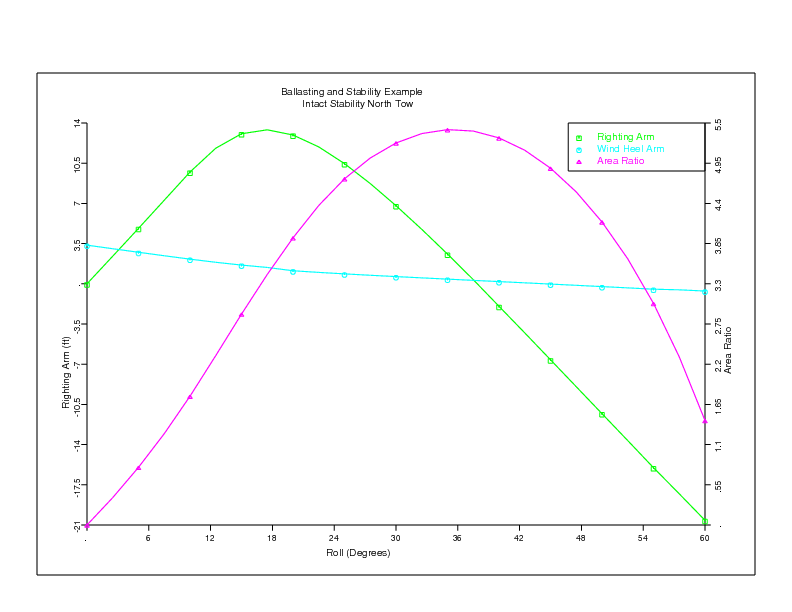- General Overview of Hydrostatics & Ballasting
- Simple Stability
- Wind Areas and Compartment Ballasting
- Plate Areas and Specific Compartment Ballasting
- Stability of a Transportation
- Allowable KG & Stability Macro
- Allowable Deck Load Macro
- Incline Macro
General Overview of Hydrostatics & Ballasting:
Traditionally, hydrostatic meant the computation of the buoyancy, center of buoyancy, etc. of a vessel for different drafts, trims, and lists (drafts, rolls, and pitches). These properties were plotted as curves to be used to place ballast and to ensure that the cargo and ballast arrangement resulted in suitable "stability".
Today, this is normally automated and most of the traditional curves survive only for historical purposes. The results, however, are just as important today as they were to Columbus. Here, we consider four separate types of hydrostatic computation:
- The equilibrium position resulting from a specified set of cargo and ballast,
- Ballasting,
- Stability Curves, and
- Longitudinal Strength.
Equilibrium and Ballasting:
To appreciate how an equilibrium finder is useful here, consider the following problem:
Suppose that you were given a ship and a set of cargo and asked to design a ballast pattern. Now, there is not a unique solution to this problem - there are many different ballast conditions which will work. Normally, the ship you were given was designed to be operated at a draft and trim which are optimal in some sense, so you could add to your charge to find the ballast which will yield the optimal draft and trim.
One way to approach this task would be iteratively - try ballast in some place and see what happens. This is where the equilibrium finder comes into play. You specify a ballast condition, find equilibrium, and see how close the result is to the desired draft and trim. You continue this process until you get the desired result. (In fact, there are automated ways to find the ballast to achieve a given draft and trim, and they will be discussed later) Now, how can you tell if the ballast condition you found is a "good" one? This is where the other computations come into play.
Longitudinal Strength:
One thing you definitely do not want to happen as a result of your ballast condition is to break the ship. Ships are designed to carry a maximum bending moment, and the longitudinal strength computation computes the ratio of the actual moment to the allowable as shown:

In this plot the bending stress to allowable bending stress is shown on the left axis and the deflection is shown on the right.
Stability:
A more subtle problem that could occur is a lack of stability. To assess stability, one normally considers the following:

Here, the green curve is the "righting arm" which is a measure of the stability of the condition. The light blue curve is the wind arm which is what makes the ship roll, and the light red curve is the ratio of the area under the righting arm curve to the area under the wind arm curve. All three of these curves are plotted as functions of roll angle. Now, when the righting arm curve crosses the wind arm curve the first time, this is the mean roll of the ship under the applied wind. When the righting arm crosses the wind arm curve the second time is an important point. If the ship is rolled beyond this point, it will roll completely over. The value of the roll angle at second crossing is obviously quite important. Some rules demand a minimum value for the second crossing, and others demand that the area ratio at the second crossing exceed some minimum value. Also, one other bad thing could happen - if there is a way for the vessel to flood before it gets to the second roll angle, then it can sink before it becomes unstable. To avoid this possibility, most rules replace the second intercept with the minimum of the second intercept or the angle at which the vessel begins to flood.
As best as we can tell, the following checks are adequate for all of the stability rules:
- The area under the righting moment curve will attain a ratio with the area under the wind heeling moment curve of at least XX, with both measured at the lesser of the downflooding angle or second intercept,
- The maximum righting arm will attain a ratio with the wind arm of at least XXX, with both measured at the angle of maximum righting arm.
- The area under the righting moment curve will be at lease XXX ft-degrees or m-degrees,
- The second intercept will be at least XXX degrees beyond the first intercept, and
- The first zero crossing will be at most XXX degrees. Here, the first zero crossing is the equilibrium heel without wind acting.
- The first intercept, or equilibrium heel due to wind, will be at most XXX degrees,
- The second intercept will be at XXX degrees.
- The minimum height of the downflooding points must be greater than XXX feet or meters at the first intercept (equilibrium position including wind),
- The down flooding angle will be greater than the first intercept,
